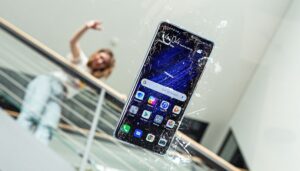It might seem incredibly obvious, but how you use and carry your smartphone on a day-to-day basis can make a huge difference for its durability. Although nowadays most devices come with Corning Gorilla Glass 6, which has been tested with shoulder-height drops and is supposedly scratch-proof, your display can still get damaged if you’re not careful.
corning gorilla glass 5
Corning’s Gorilla Glass 5 is used on most Android smartphones nowadays. / © Corning
One of the easiest and most common ways people scratch their screen is because they put their phone in the same pocket as their keys or change. When you’re walking, there will be friction between them, resulting in mini-scratches – unless you have a screen protector. If you do this and don’t believe us, have a good look at your phone’s screen next time it’s sunny outside.
What is the best material for smartphones and tablets?
Another piece of advice, which might seem obvious, but which many don’t follow, is to actually test how your new smartphone feels in your hands before purchasing it. Slippery materials or smartphones that are too big for your hands are a recipe for dropping and possibly damaging your device. So if you have the chance, go to a shop and test your phone before you order it online. Also, be careful when cycling, you don’t want to have your phone slip our of your trouser pocket, as one of our Editor’s experienced with his Huawei P30 Pro.
Cover your screen
If you have already taken the above steps, but you still want to be on the safe side (or you are clumsy), screen protectors will help. However, when trying to purchase one online you might be overwhelmed by the variety. This is why we will explain what each option offers.
Plastic
The cheapest and most-preferred option for many are plastic stick-on screen protectors. They are light, not very noticeable and easy to apply. However, they also offer the least protection. The two varieties you’d often find online are Polyethylene Terephthalate (PET) or Thermoplastic Polyreuthane (TPU).
PET protectors are sturdy and often not suitable for phones with curved screens, but they are very easy to apply. In comparison, TPUs are a lot more flexible, but require more effort to install and might give your screen a yellow-ish tint. Bubbles between the TPU protector and the screen are also likely to appear.
Glass
Tempered glass protectors are a step above plastic. They are a lot more durable and protect not only from scratches and day-to-day wear, but drop damage too. However, tempered glass protectors are not one-size fits all like most of their plastic cousins – you have to be careful to purchase one that’s specifically made to fit your smartphone.
galaxy s8 screen protectors
Galaxy S8 tempered glass screen protector/ © @DforDesign
The prices of these protectors have also significantly dropped in recent years – you can find reliable ones for less than $10. More expensive versions with a matte finish, anti-UV layers and other interesting options are also available. They’re probably the best choice for clumsy users.
Source: https://www.nextpit.com/how-to-protect-your-android-device-screen
- https://www.nextpit.com/
- Samsung
- South Korea







